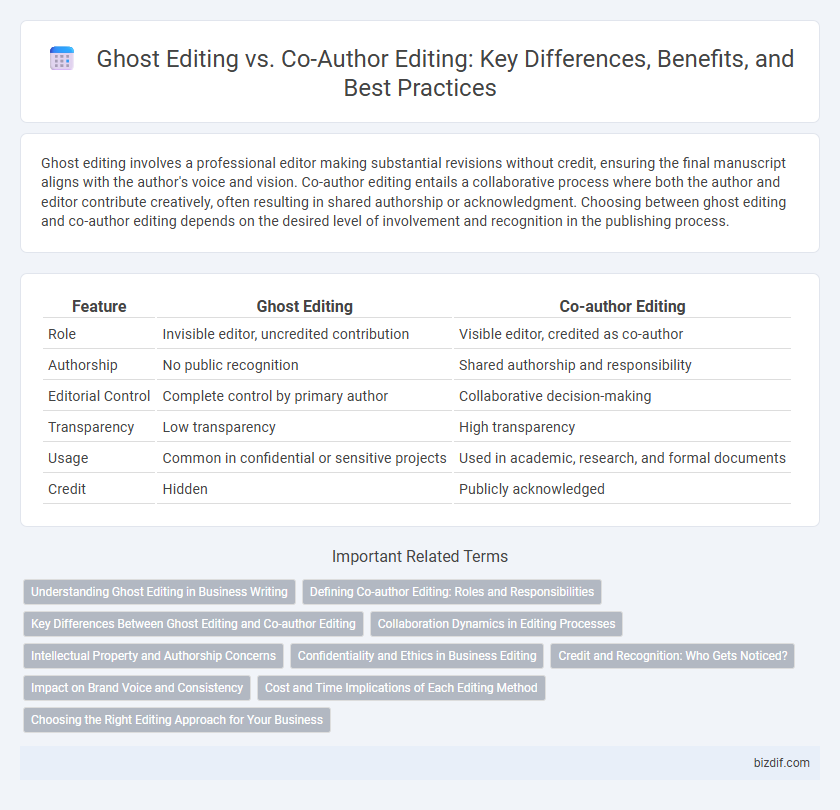Ghost editing involves a professional editor making substantial revisions without credit, ensuring the final manuscript aligns with the author's voice and vision. Co-author editing entails a collaborative process where both the author and editor contribute creatively, often resulting in shared authorship or acknowledgment. Choosing between ghost editing and co-author editing depends on the desired level of involvement and recognition in the publishing process.
Table of Comparison
| Feature | Ghost Editing | Co-author Editing |
|---|---|---|
| Role | Invisible editor, uncredited contribution | Visible editor, credited as co-author |
| Authorship | No public recognition | Shared authorship and responsibility |
| Editorial Control | Complete control by primary author | Collaborative decision-making |
| Transparency | Low transparency | High transparency |
| Usage | Common in confidential or sensitive projects | Used in academic, research, and formal documents |
| Credit | Hidden | Publicly acknowledged |
Understanding Ghost Editing in Business Writing
Ghost editing in business writing involves a professional editor who refines and enhances a document without receiving public credit, ensuring confidentiality and maintaining the original author's voice. This approach is favored in corporate communications, white papers, and executive reports where the end document reflects the client's expertise while benefiting from expert editorial polish. Unlike co-author editing, which involves collaborative input and shared authorship, ghost editing preserves the appearance of sole authorship, crucial for maintaining brand consistency and authorial authority.
Defining Co-author Editing: Roles and Responsibilities
Co-author editing involves collaborative writing where each contributor shares responsibilities in content development, revision, and decision-making, ensuring alignment with the project's goals. Both parties actively participate in drafting, refining, and integrating ideas, fostering a balanced creative partnership. This contrasts with ghost editing, where the editor's contributions remain uncredited and primarily focus on polishing the author's original text.
Key Differences Between Ghost Editing and Co-author Editing
Ghost editing involves an editor making extensive, often uncredited revisions to a manuscript to refine style, structure, and clarity, preserving the original author's voice without public acknowledgment. Co-author editing entails collaborative writing where the editor actively contributes ideas, content, and revisions, sharing authorship credit and responsibility. The key differences lie in the visibility of the editor's role, with ghost editing maintaining anonymity and co-author editing resulting in shared recognition.
Collaboration Dynamics in Editing Processes
Ghost editing involves a single editor making substantial revisions without author credit, fostering a unilateral workflow with limited author input. Co-author editing emphasizes collaborative partnership, where both editor and author actively contribute to shaping the manuscript, enhancing creative synergy and shared ownership. This dynamic directly influences the editing process's transparency, decision-making, and final content quality.
Intellectual Property and Authorship Concerns
Ghost editing involves an editor making significant contributions to a manuscript without public acknowledgment, raising complex intellectual property issues since the editor's role remains uncredited, which may challenge the transparency of authorship. Co-author editing entails collaborative input with clear authorship attributions, protecting contributors' intellectual property rights and ensuring shared accountability for the content. Ethical considerations in scholarly publishing emphasize proper acknowledgment to prevent disputes over authorship and maintain the integrity of intellectual contributions.
Confidentiality and Ethics in Business Editing
Ghost editing prioritizes strict confidentiality by maintaining complete anonymity, ensuring the editor's contributions remain undisclosed, which upholds client privacy and trust. Co-author editing involves transparent collaboration where both parties receive credit, fostering ethical accountability and clear intellectual property rights. In business editing, balancing confidentiality with ethical recognition safeguards professional integrity and client relationships.
Credit and Recognition: Who Gets Noticed?
Ghost editing involves an editor making substantial contributions to a manuscript without receiving public acknowledgment, resulting in the primary author receiving all credit and recognition. Co-author editing credits both the original author and the editor, reflecting shared intellectual ownership and increasing visibility for both parties within academic and literary circles. The choice between ghost editing and co-author editing significantly impacts professional reputation, influencing future collaboration opportunities and career advancement.
Impact on Brand Voice and Consistency
Ghost editing preserves the original author's brand voice by making subtle improvements without altering the unique style, ensuring consistency throughout the content. Co-author editing involves collaborative input, which can introduce diverse perspectives but risks diluting the original brand voice if not carefully managed. Maintaining a consistent tone is critical for brand recognition, making the choice between ghost editing and co-author editing pivotal for content strategy.
Cost and Time Implications of Each Editing Method
Ghost editing typically incurs higher costs due to the editor's exclusive work behind the scenes, often requiring extensive hours to perfect the manuscript without public credit. Co-author editing can reduce expenses and turnaround time by leveraging collaborative input, allowing simultaneous revisions and shared creative responsibilities. Choosing between ghost editing and co-author editing depends on budget constraints and the need for expedited project completion.
Choosing the Right Editing Approach for Your Business
Choosing between ghost editing and co-author editing depends on your business's goals and collaboration style. Ghost editing offers complete anonymity and control over the final content, ideal for businesses seeking a polished, consistent voice without shared credit. Co-author editing fosters a collaborative process, blending expertise and increasing transparency, which can enhance credibility and audience trust.
Ghost Editing vs Co-author Editing Infographic

 bizdif.com
bizdif.com